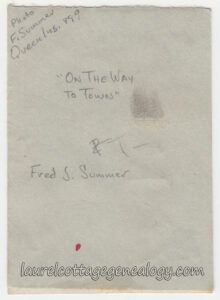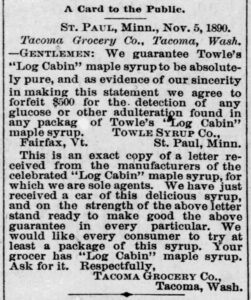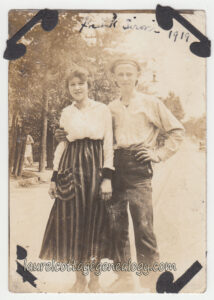Old photo, white border, circa 1915 – 1920.
Price: $20.00 Size: About 2 and 1/4 x 3 and 1/8″
“Photo. F. Summer. Queen Ins. p. 89”
“On The Way To Town”
“Fred J. Summer”
Sporting a cigar and bow tie, a young man with a gregarious smile, (a people person is a good fit for the insurance business) takes a break to pose for this picture.
Biographical data
According to his WWII Draft Registration, Fred John Summer was born December 8, 1900, though his first marriage record shows his birthday as January 8, 1898. He was born in London, England to Steven Summer and Clementine (Piruska) Summer. He married Hinda R. Fancher in 1919 in Indiana, but again in 1941, so they evidently had divorced. They had two children, Fred Orville Summer and Geraldine Summer. A third marriage was found, in Family Search, to Leslie Armantrout in Dubuque, Iowa. (Armantrout was the bride’s prior married name.) An image of this marriage is not online, and the transcription does not provide the marriage date (quite unusual). Fred passed away in Florida in 1965.
An early start to a successful career
The Queen Insurance Company of America was based in New York City but, according to an old envelope found on eBay, had offices in other states. This coincides with the second newspaper clipping (below) that reported that Fred started working (at age fifteen) for an “eastern insurance company”. Soon after that he started his own company, The Summer Agency, which became a very successful firm. Their slogan was, “where insurance is a business (not a sideline)”. The company’s long-term address in Chicago was 2145 E. 83rd St., Chicago. (If Fred was born in 1900, that would put him at age fifteen for starting his company – possibly the truth had been stretched a bit in the 25 year anniversary notice. (From researching other companies, this was not uncommon.)
Anniversary notice in The Daily Calumet (Chicago, Illinois). May 20, 1940:
In 1942, he moved to California, where in 1954, he became a Million Dollar Writer. Below, from the Oakdale Leader, December 20, 1956:
Sources: “Illinois, World War II Draft Registration Cards, 1940-1945”, , FamilySearch (https://www.familysearch.org/ark:/61903/1:1:QPH8-1TY4 : Sat Mar 09 16:29:12 UTC 2024), Entry for Fred John Summer and Self, 16 February 1942.
“Indiana Marriages, 1811-2019”, , FamilySearch (https://www.familysearch.org/ark:/61903/1:1:KDH7-QLK : Fri Mar 08 18:52:51 UTC 2024), Entry for Fred J Summer and Hinda Fancher, 13 Mar 1919.
“Indiana Marriages, 1811-2019”, , FamilySearch (https://www.familysearch.org/ark:/61903/1:1:D4FD-RXT2 : Sun Mar 10 01:54:09 UTC 2024), Entry for Fred J Summer and Leslie Armantrout.
Carroll, B. F. Thirty-seventh Annual Report of the Auditor of State of the State of Iowa on Insurance Other Than Life, 1906, Vol 1. “Queen Insurance Co. of America, New York, N.Y.” P. 560. (google.com/books.)
Queen Insurance Company of America Advertising Cover (-699). https://www.ebay.com/itm/122521912348. (Accessed March 28, 2024.)
“Fred J. Summer, Marking 25th Anniversary, Warns Against False Economy.” The Daily Calumet (Chicago, Illinois). May 20, 1940. Monday, p. 3. (Newspapers.com).
“Insurance Speaker in Modesto Tomorrow.” Oakdale Leader (Oakdale, California). December 20, 1956. Thursday, p. 8. (Newspapers.com).






















